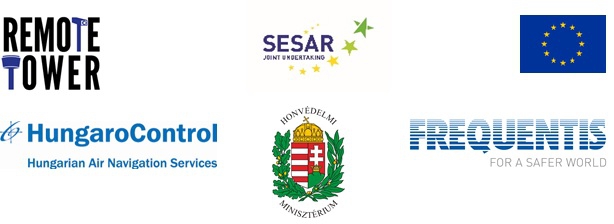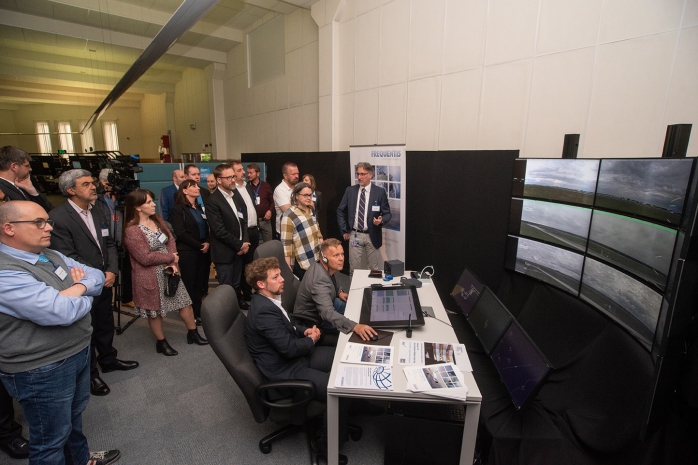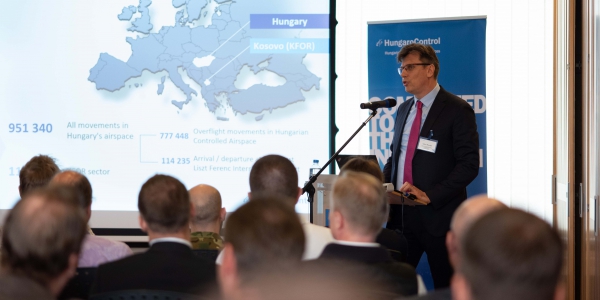Successful SESAR PJ05 multi-remote passive shadow validation and open day at HungaroControl
April 2019, Budapest – Air Traffic Management (ATM) experts from around the world gathered at HungaroControl’s headquarters in Budapest to experience a passive shadow validation for multiple remote tower technology carried out in collaboration with Frequentis. Participants got to see first-hand the passive management of three airports simultaneously in real time.
Remote towers are already a reality for leading Air Navigation Service Providers (ANSP) across the world. This operating concept is at the forefront of ATM service provision, however the benefit envelope continues to be expanded by the multi-remote tower concept, where an air traffic controller can provide services to multiple aerodromes. Under this expanded concept, service providers can begin to truly harvest the cost-efficiency, flexibility and operational resilience benefits that are offered with a remote tower capability. The PJ05 project of SESAR is bringing this expanded concept to a higher level of maturity through an eco-system of strong industry partnerships, including ANSPs, technology suppliers, research & development organisations, and airport stakeholders.
The first multi-remote validation using Frequentis’ system took place in DLR’s (Deutsches Zentrum für Luft- und Raumfahrt e.V.) simulator in Braunschweig, Germany, in November 2017 and 2018. This formative simulation looked at how a single air traffic controller could control three airports simultaneously in a Multi-Remote Tower Module (MRTM); three Hungarian airports were used as the scenario environments for the simulation (i.e. Budapest Airport, Pápa Military Airbase, and Debrecen Airport).
The recent event was co-hosted by DLR, responsible for project coordination within SESAR, Frequentis as the technology partner, and HungaroControl as the experienced ANSP to implement this experimental concept into daily operations. This passive shadow validation took the MRTM concept one step further. Camera systems were installed at the three airports involved in the project that provided live video streams that are displayed on a monitor wall. Apart from the video stream, controllers are supported by live radar information, can listen to live radio communication and get relevant flight information from Frequentis’ system.
“The solution offers new possibilities for small or local airports where the building, maintaining, and staffing of a conventional tower is unaffordable. More efficient and cost-effective deployment of operational resources, improving services continuity and maintaining safety at the same time. Although this is still a Research & Development phase project, we are confident that will see fully operating multi-remote towers at the most innovative ANSPs in the upcoming years“ stated Péter Kántor, Project Manager at HungaroControl.
Hannu Juurakko, Vice President ATM Civil at Frequentis, said: “Our innovative remote solutions are already used around the world and provide safe and risk-free operations. This advanced multi-remote technology enables air traffic controllers to be able to supervise multiple aerodromes and reap the maximum benefits from such a solution.”
Experimental multiple remote tower operations clearly show that both technologically and from a human factor point of view it will be possible for a single air traffic controller to safely provide air traffic control services remotely to more than one airport. The validation results showed the operational feasibility of the concept and provide good foundation for further developments.
More information about PJ05 / remote tower is to be found on www.remote-tower.eu
This project has received funding from the SESAR Joint Undertaking under the European Union's Horizon 2020 research and innovation programme under grant agreement No. 730195.
Background information about SESAR
As the technological pillar of the Single European Sky initiative, SESAR aims to modernise and harmonise air traffic management in Europe. The SESAR Joint Undertaking (SESAR JU) was established in 2007 as a public-private partnership to support this endeavour. It does so by pooling the knowledge and resources of the entire ATM community in order to define, research, develop and validate innovative technological and operational solutions. The SESAR JU is also responsible for the execution of the European ATM Master Plan which defines the EU priorities for R&D and implementation. Founded by the European Union and Eurocontrol, the SESAR JU has 19 members, who together with their partners and affiliate associations will represent over 100 companies working in Europe and beyond. The SESAR JU also works closely with staff associations, regulators, airport operators and the scientific community.
Detailed information about DLR can be found on the website: https://www.sesarju.eu/
Background information about FREQUENTIS
Frequentis is an international supplier of communication and information systems for control centres with safety-critical tasks. These control centre solutions are developed and distributed by Frequentis in the business segments Air Traffic Management (civil and military air traffic control, and air defence) and Public Safety & Transport (police, fire and rescue services, emergency medical services, vessel traffic and railways). Frequentis maintains a worldwide network of subsidiaries and local representatives in more than fifty countries. The company’s products and solutions are behind more than 25,000 operator positions in almost 140 countries. With this extensive portfolio, Frequentis is the leading provider of voice communication systems… all making our world a safer place every day! For more information, please visit www.frequentis.com
Background information about DLR
DLR is the national aeronautics and space research centre of the Federal Republic of Germany. Its extensive research and development work in aeronautics, space, energy, transport and security is integrated into national and international cooperative ventures. In addition to its own research, as Germany’s space agency, DLR has been given responsibility by the federal government for the planning and implementation of the German space programme. DLR is also the umbrella organisation for the nation’s largest project management agency.
DLR has approximately 8,000 employees at 20 locations in Germany: Cologne (headquarters), Augsburg, Berlin, Bonn, Braunschweig, Bremen, Bremerhaven, Dresden, Goettingen, Hamburg, Jena, Juelich, Lampoldshausen, Neustrelitz, Oberpfaffen-hofen, Oldenburg, Stade, Stuttgart, Trauen, and Weilheim. DLR also has offices in Brussels, Paris, Tokyo and Washington D.C.





